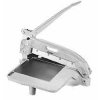Hello. I'm trying to find a home-made PCB method that's compatible with fine spacing requirements. I'm planning on using a home-method due to cost and time requirements and I'm trying to find something that's feasible for TQFP-32 type where the footprint has pads that are spaced somewhere around 8-9 mil apart. Is there such a method available? I've tried the toner transfer method and seem to have occasional problems with anything below 20 mil and I've heard about UV's precision, but is it really suitable for something like 8-mil spacing? I'm trying to prototype this TQFP-32 packaging that seems to have 8 mils spacing between the pads and I definitely don't think it's possible with the Toner transfer method. Or is it? Is Pulsar paper or any other special paper (Even with a special laminator of some sort?) suitable for these kind of requirements?


